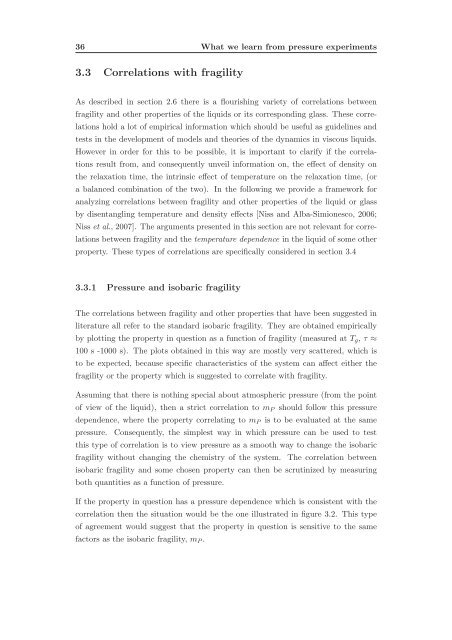Ph.D. thesis (pdf) - dirac
Ph.D. thesis (pdf) - dirac
Ph.D. thesis (pdf) - dirac
You also want an ePaper? Increase the reach of your titles
YUMPU automatically turns print PDFs into web optimized ePapers that Google loves.
36 What we learn from pressure experiments<br />
3.3 Correlations with fragility<br />
As described in section 2.6 there is a flourishing variety of correlations between<br />
fragility and other properties of the liquids or its corresponding glass. These correlations<br />
hold a lot of empirical information which should be useful as guidelines and<br />
tests in the development of models and theories of the dynamics in viscous liquids.<br />
However in order for this to be possible, it is important to clarify if the correlations<br />
result from, and consequently unveil information on, the effect of density on<br />
the relaxation time, the intrinsic effect of temperature on the relaxation time, (or<br />
a balanced combination of the two). In the following we provide a framework for<br />
analyzing correlations between fragility and other properties of the liquid or glass<br />
by disentangling temperature and density effects [Niss and Alba-Simionesco, 2006;<br />
Niss et al., 2007]. The arguments presented in this section are not relevant for correlations<br />
between fragility and the temperature dependence in the liquid of some other<br />
property. These types of correlations are specifically considered in section 3.4<br />
3.3.1 Pressure and isobaric fragility<br />
The correlations between fragility and other properties that have been suggested in<br />
literature all refer to the standard isobaric fragility. They are obtained empirically<br />
by plotting the property in question as a function of fragility (measured at T g , τ ≈<br />
100 s -1000 s). The plots obtained in this way are mostly very scattered, which is<br />
to be expected, because specific characteristics of the system can affect either the<br />
fragility or the property which is suggested to correlate with fragility.<br />
Assuming that there is nothing special about atmospheric pressure (from the point<br />
of view of the liquid), then a strict correlation to m P should follow this pressure<br />
dependence, where the property correlating to m P is to be evaluated at the same<br />
pressure. Consequently, the simplest way in which pressure can be used to test<br />
this type of correlation is to view pressure as a smooth way to change the isobaric<br />
fragility without changing the chemistry of the system. The correlation between<br />
isobaric fragility and some chosen property can then be scrutinized by measuring<br />
both quantities as a function of pressure.<br />
If the property in question has a pressure dependence which is consistent with the<br />
correlation then the situation would be the one illustrated in figure 3.2. This type<br />
of agreement would suggest that the property in question is sensitive to the same<br />
factors as the isobaric fragility, m P .

















